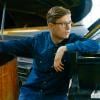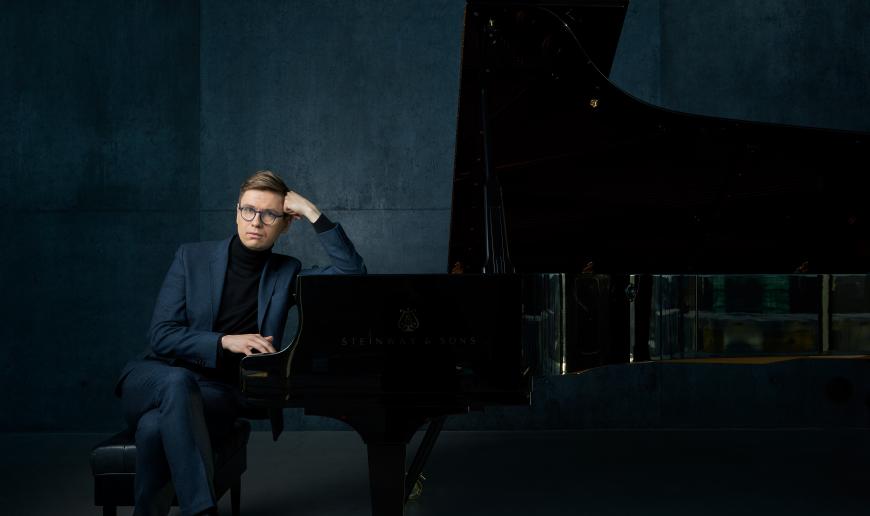
In a recent Instagram post, pianist Víkingur Ólafsson tells the story of how his parents “spent all of their money and even took a loan to buy a Steinway grand piano before they bought [an] apartment,” adding that “it was a crazy economic decision.” It was only outrageous, perhaps, because the musician hadn’t been born yet. But that decision has paid off handsomely, as Ólafsson, 39, continues to make a profound impact on audiences around the world with his combination of extraordinary musicianship and inventive programming.
Not for nothing did The New York Times hail him as “Iceland’s Glenn Gould,” while The Daily Telegraph dubbed him “the new superstar of classical piano.” Ólafsson’s talents will be on full display when he gives recitals at San Francisco’s Herbst Theatre on May 9 and at Los Angeles’ Walt Disney Concert Hall on May 10, with both programs featuring the music of Baldassare Galuppi, Mozart, C.P.E. Bach, Domenico Cimarosa, and Haydn.
Growing up in Reykjavík, where he is still based, Ólafsson started at the keyboard with his mother, a piano teacher, and went on to earn bachelor’s and master’s degrees from The Juilliard School. With his charismatic performance style, dynamic energy, and deep focus, the Icelander has concertized with the world’s leading orchestras, including the Los Angeles Philharmonic, the Berlin Philharmonic, and The Cleveland Orchestra, to name a few.
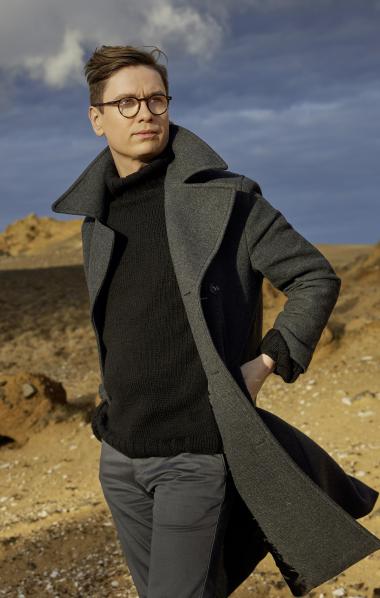
Along the way, Ólafsson has also garnered multiple awards: Gramophone magazine’s 2019 Artist of the Year, Opus Klassik Solo Recording Instrumental (twice), Album of the Year in the 2019 BBC Music Magazine Awards, and last year, the Rolf Schock Prize in Musical Arts. In addition, the pianist was artist-in-residence for three months on BBC Radio 4’s flagship arts program, Front Row, and during the pandemic lockdown, he broadcast live from an empty Harpa concert hall in Reykjavík, broadening his reach to millions of listeners around the world.
Then there’s Ólafsson’s impressive, chart-topping Deutsche Grammophon discography. Included are Philip Glass: Piano Works (2017), Johann Sebastian Bach (2018), Debussy/Rameau (2020), and Mozart & Contemporaries (2021), all of which led to streams in the hundreds of millions.
SF Classical Voice caught up with Ólafsson by Zoom from Essen, Germany, where he was performing with the Essen Philharmonic. Topics ranged from programming a recital and the state of contemporary music to his relationship with Hungarian composer György Kurtág.
What did you think when The New York Times called you “Iceland’s Glenn Gould?” Has it been hard to live up to? Did you dismiss it?
I like The New York Times and think they’re very brilliant writers. Coming from them, I was quite happy that this young, upcoming artist [was] being likened to someone else, or someone from the past. [But] everybody from the 21st century is supposed to be somebody else. I’ve heard so many times, “He’s the new [Vladimir] Horowitz. She’s [Martha] Argerich.” I thought, “They chose Glenn Gould, that’s wonderful.” I did, in a certain sense, identify with him. He was the first real recording artist. His was the first musical love affair with the microphone. Yes, I love live performance, but I love the studio. He opened the door, [so] I was happy.
Of course, it’s a double-edged sword. I’m not Glenn Gould, and nobody is. Well, of course, people would say, “He’s not Glenn Gould. He’s nowhere near Glenn Gould.” But the good thing about that is it seems to have cut through. For me, it’s a game. It’s funny. It makes people aware of the work and listen to it. This was six years ago, and it came at a good time, because I don’t think too much about that or anyone telling me who I am. I try to keep away from that. You have to think about art for yourself.
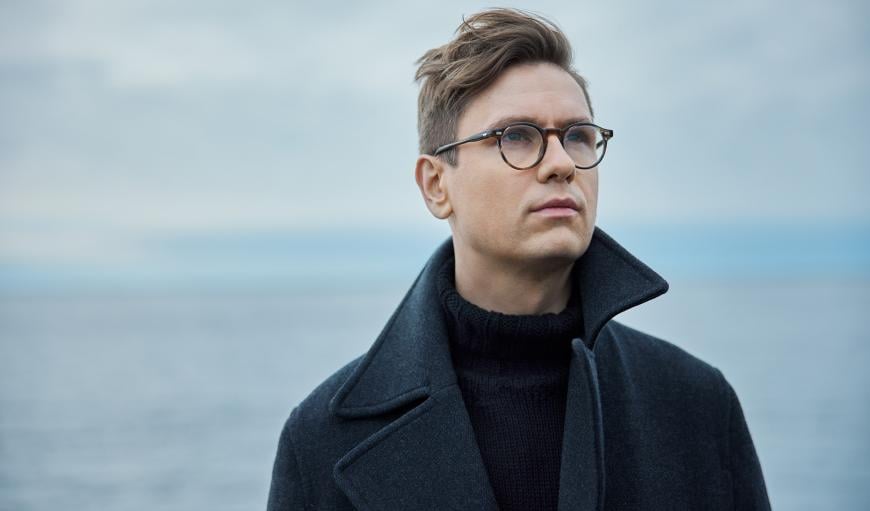
It’s obvious that you do think about art, especially when programming a recital with Mozart as the centerpiece. In addition to his rondos, sonatas, a transcribed string quintet, and the like, you also play works by C.P.E. Bach, Baldassare Galuppi, Domenico Cimarosa, and Haydn. Why those pieces?
I wanted to have a Mozart sort of focus and examine Mozart. I didn’t just want to do Mozart and three sonatas and “that’s a great program.” I wanted to figure out what makes Mozart Mozart and what makes him distinct from his contemporaries. I also wanted to point out that there were other amazing people in his time — and he was [musically] taken by them. They were part of an ecosystem in that music in the past, [and] we tend to isolate them.
I also wanted to build something that would maybe give my audience a new insight into who Mozart was. By going with lesser-known composers and juxtaposing them with pieces by Mozart that many of us know, it makes us listen differently.
This program I think of as a single entity, almost like a collage from the first piece to the last. I thought of it as I was building a musical structure like a Mozart exhibition. That’s what prompted these choices. I wanted to put Mozart in dialogue with his time and with other composers. I spent a year to find which composers would speak to me meaningfully and to the works of Mozart that I chose.
You occasionally wield a microphone to speak from the stage before a recital. Case in point: Last year in New York you called Mozart a “late bloomer,” with The New York Times’ Zachary Woolfe comparing you to a wry and deprecating stand-up comic.
I like to do it for this program, [but] I only do it at the top of the program. I want the program to be like a sequence, [where] one piece melds into the next. Now I’m just doing concerts and recordings, [but] before I had an international career, and nobody heard of me. I had to create opportunities. I did a TV series on music and radio programs on music, to do journalism in music. That’s maybe why I enjoy speaking to my audience.
It’s kind of sad it has to be a surprise, and I was shocked by it. Because it’s not conventional, I almost always expect people to have a pushback — that they won’t like it. But people are quite happy about it. What makes a concert like a sacred experience? You don’t want to break it up and make it into a lecture, but if you know how to use words and which to choose, it can be interesting. It’s a massive program I’m doing, and there is a 95 percent chance that I will say something at both concerts.
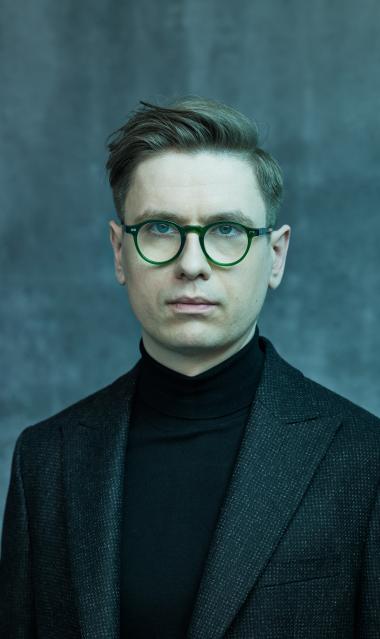
Your most recent album, From Afar, dropped last October and contains interconnected works by the legendary Hungarian composer György Kurtág and music ranging from Bach to Thomas Adès. You’ve said that meeting Kurtág left you with “a feeling of lightness and joy.” How so, and how is he doing at age 97?
I’ll see him in one month in Budapest, just after my U.S. tour for the [György] Ligeti 100th-anniversary celebration. I think he’s doing great. I saw him in October, and he gave me Hungarian cookies in his home. When I met him the first time, for me it was like meeting Robert Schumann. I think he’s the greatest genius.
He’s just different from the rest. He has his own way, and every piece he writes is completely unpredictable and ingenious. To meet someone you revere, the lightness [was that] he seemed to be unaware of himself and we were just in the music. I played for him pieces from [Béla] Bartók, Hungarian and Icelandic folk songs, Mozart, Haydn. We had this communion that was life-affirming for me.
You also recorded the music for the album twice — on an upright piano and on a Steinway concert grand. Why?
The more conventional [sound] is from the grand piano. It’s like different interpretations. [With the upright for this recording], there was felt between the hammers, in the strings, so it’s trying to find the nuance between [the two instruments]. It’s almost like the difference between a viola and a violin. But I only like the upright when it has a super-soft sound going on. Otherwise, if you don’t have that, I think the upright is a bad version of a grand piano. It becomes a different instrument with the felt, [and] the challenge is to play it extremely dynamically so it doesn’t sound sweet and soft.
“Sweet” and “soft” aren’t exactly descriptors of today’s contemporary music. How do you feel about the new-music scene, and how does Iceland figure into it?
I think it’s great. I’m having a wonderful time. I’m entering more and more into classical concerts [where] boundaries between new and old are getting blurred. People are expected to bring something new with old masters; not all are middle-aged white guys, politically speaking. It’s more musically diverse. People do what they want — they follow their hearts.
In the 1970s and ’80s, [composers] were afraid to follow their hearts and had to hang on to ideology. There was a resistance to beauty in a way. That has vanished. People are more open to being themselves — who they are as people and how they identify themselves. That translates beautifully into music. They do what they believe, and no one’s expected to follow the [1950s and ’60s] Darmstadt School. This is good news.
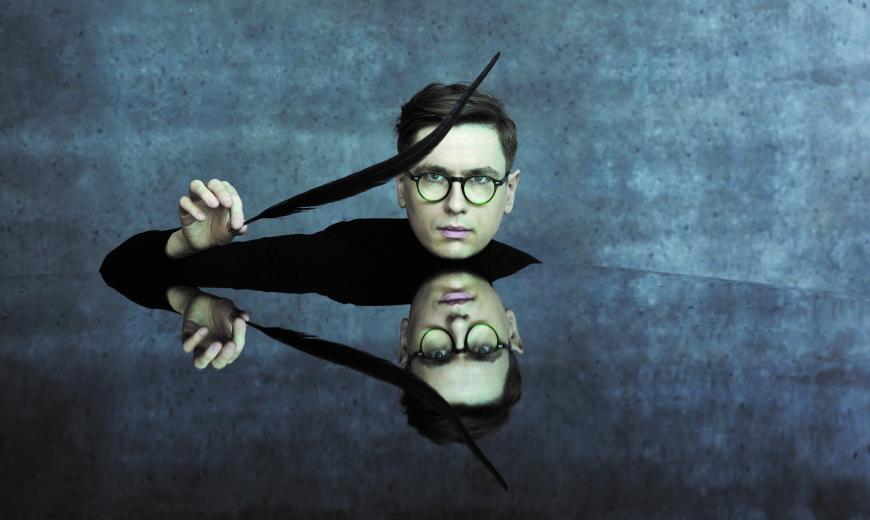
As for Iceland, it’s a good place for music. It’s a strange island — somehow in between Europe and America — and everybody identifies us as a European nation, but I say we’re closer to America geographically. We take a lot of cultural influence from the West, as we do from the East. I think it’s a nice melting pot. We don’t have a heavy, overbearing history, like some countries, and that can be a good thing in the case of Iceland.
Where do you see yourself in the next 5 to 10 years?
I see myself alive, to begin with. I’m turning 40 [next] Valentine’s Day, and to celebrate that, I’m going to play the Goldberg [Variations] in Reykjavík, where I make my recordings. It will be a big party. I’ve been thinking now, where I am, I feel like I’m 20. [But] where am I going? What is my life?
I have incredible relationships in music. John Adams is writing me a new piano concerto, and some other fantastic composers are writing for me. I have an incredible relationship with Deutsche Grammophon and have fortunately been able to record and have a large audience. It’s a golden age in classical music. I [had] never [before] played such a big role in the lives of people. In five years, my recordings have 600 million streams. These are crazy numbers, and I’m only one artist. I can see the live numbers of how many people are listening at any given time, and it’s more than 1,000 people at any time of the day. And I’m only one person in classical music. If you take the rest of us [performers], people are listening to Beethoven, Bach, and Chopin more than ever before.
When Mozart was writing the music I’ll play in L.A., he would have been happy to have an audience of 250 people. There were no recordings. There was no circulation. That was a closed community, and now it’s incredibly open, and people are listening much more. During the pandemic, people went actively to music because they wanted it in their lives. I hope to be doing what I’m doing for an ever-bigger audience with open minds and hearts.
On a personal level, I want to be father to the two sons I have and find an ideal balance. If I can contribute as a performer by bringing to life pieces by Adams and other incredible composers I get to work with, that’s meaningful to me — and also playing Bach in my 40s.Yes, I hope to play a lot of Bach.
Speaking of Bach, what’s on your playlist? Fellow Icelander Björk, Beyoncé, Bach?
Bach more than Björk and Beyoncé — 100 times more. I like pop music, especially one artist I listen to, Taylor Swift. I’m not fond of her songs as such, but I love something about the way they’re produced and done. It’s an unbelievable soundscape. She’s actually wonderful. I listen to different things. My go-to is more jazz and sometimes piano jazz — Bill Evans. I was just in Brussels with Brad Mehldau. We had dinner, and I was taken by him as well, so add a fourth B.



